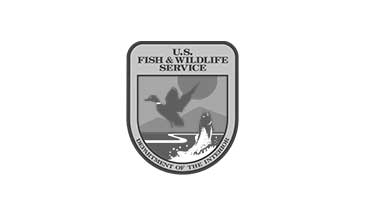Bat Removal & Exclusion Services
Do you have a bat problem in your home or business? We can help. Contact us today for bat removal and exclusion services!
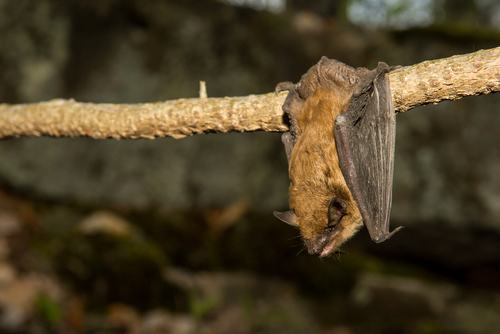
Wildlife Removal: Bats
Bats are mammals that belong to the order Chiroptera. They have forelimbs adapted as wings which make them the only mammals that can fly.
Common Name: Big Brown Bat / Little Brown Bat Scientific Name: Eptesicus Fuscus / Myotis Lucifugus
Bat Birthing Season By State:
- Ohio: May 15 - July 31
- Minnesota: June 1 - July 31
- Michigan: May 20 - August 15
- Kentucky: May 15 - August 15
- Pennsylvania: May 15 - July 31
- Indiana: May 15 - August 15
- Illinois: May 15 - August 5
Bat Problems: The Dangers of an Infestation
Whether you’ve got one bat or an entire colony in your home, you need wildlife bat removal ASAP. Bats aren’t only unnerving, they also cause health risks, including:
-
Rabies. People or animals that have been bitten by a bat should be treated by a physician or veterinarian. If possible, the bat in question should be collected and tested. Don’t ever handle bats, even if they appear healthy.
-
Histoplasmosis. This is an infection that occurs from breathing in fungal spores found in bat guano (bat droppings). When bats congregate unchecked in your attic, in your basement, or inside of your walls, they can produce large amounts of unhealthy waste. This is why having a professional perform removal and clean up is crucial.
Unsure how to keep bats out of your space? Keep reading or get in touch with Varment Guard!
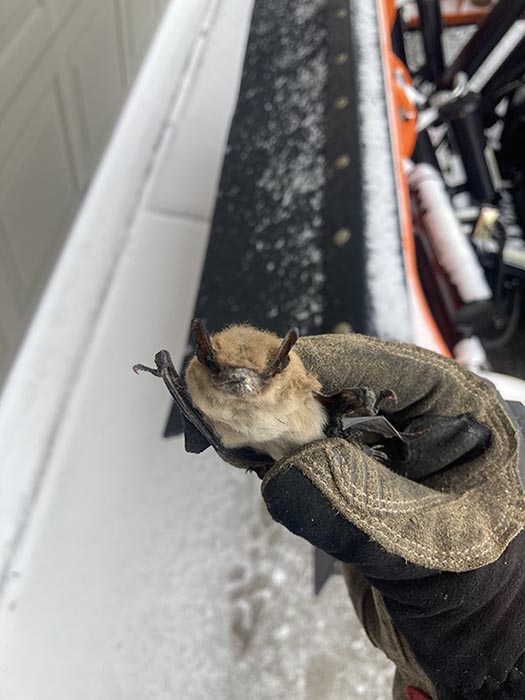
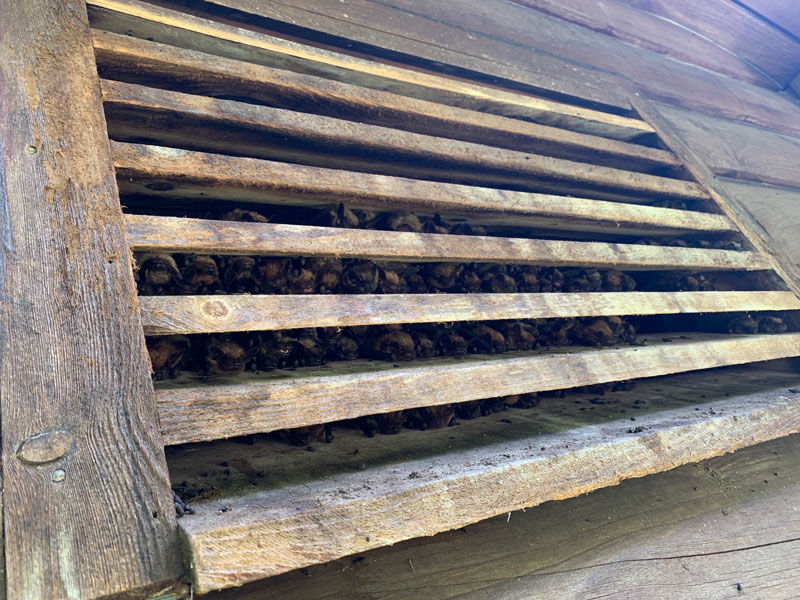
Humane Bat Exclusion Services
Bats are valuable contributors to the ecosystem and control insect populations. Bats eat flying insects like mosquitoes, for example. A bat colony may even eat thousands of insects in a single evening in preparation for their winter hibernation... but that doesn't mean you want them in your house!
This is why Varment Guard focuses on efficient and humane removal of bats. Our goal: keep bats outside so they can do their job (and give you peace of mind). We offer:
- Bat Trapping & Removal
- Bat Prevention & Exclusion
- Entry Point & Damage Repair
Request A Service
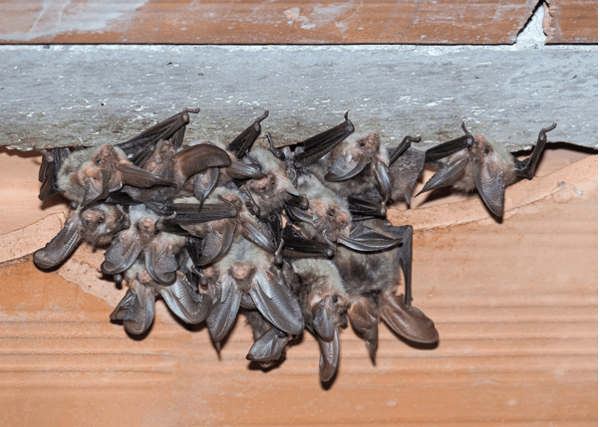
How Are Bats Getting In My House?
Most people think that bats entered through the chimney. That can be the case, however, our bat experts rarely find that bats enter living spaces that way.
Bats almost always enter through the attic and then get into the living space through a crack, gap, or hole in the interior of your home. Once a bat is in the living space, it may gravitate to the fireplace because it can feel a draft of air coming from the chimney.
Removing the Bats
Removal of bats is done by a process of excluding the structure of all potential bat entries and placing a one-way door directly over the main entry points. This allows the bats to humanely exit the structure at night. Once the bats have gone out the one-way door unharmed, they are able to find a new roosting area, preferably out of human contact.
The Big Brown Bat
- Scientific name: Eptesicus Fuscus
- Adult wingspan: 13 to 16 inches
- Body length: 3 1/2 to 5 1/2 inches
- Body coloration: Dark brown, reddish-brown or light brown
- Gestation period: 60 days
- Breeding season: Autumn
- Birthing season: May through June (1 young per female)
- Age at which young are weaned: 3 to 4 weeks
- Activity period: Night
- Roost or colony size: 20 to 500 females
- Autumn & winter behavior: Hibernate in homes, buildings, storm sewers, caves and mines
- Primary diet: Moths, flies, beetles, mayflies, stoneflies, winged ants, and other small flying insectsPrimary diet: Moths, flies, beetles, mayflies, stoneflies, winged ants, and other small flying insects
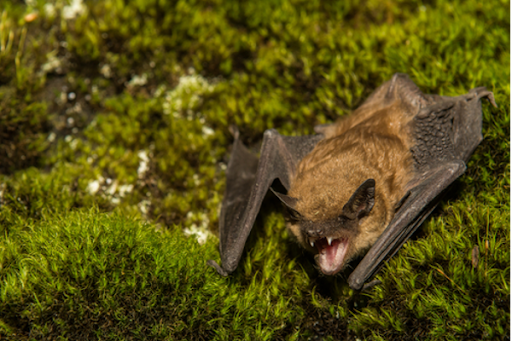
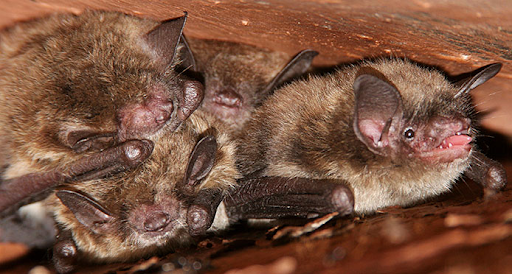
Little Brown Bat
- Scientific name: Myotis Lucifugus
- Adult wingspan: 9 to 11 inches
- Body length: 2 1/2 to 4 inches
- Body coloration: Dark brown, reddish-brown or pale tan
- Gestation period: 60 days
- Breeding season: Autumn
- Birthing season: May through July (1 young per female)
- Age at which young are weaned: 14 days
- Activity period: Night
- Roost or colony size: Hundreds to thousands
- Autumn & winter behavior: Migrate to winter roosts; hibernate in caves and mines
- Primary diet: Moths, crane flies, beetles, mayflies, gnats and other small flying insects
Do you have a bat infestation? Don’t stress. Varment Guard offers brown bat removal!
Clean-Out & Restoration Services After a Bat Infestation
Once a bat or bat colony enters your home, they can leave quite the mess. Varment Guard specializes in complete attic clean-out and restoration as well as partial clean outs after a bat infestation.
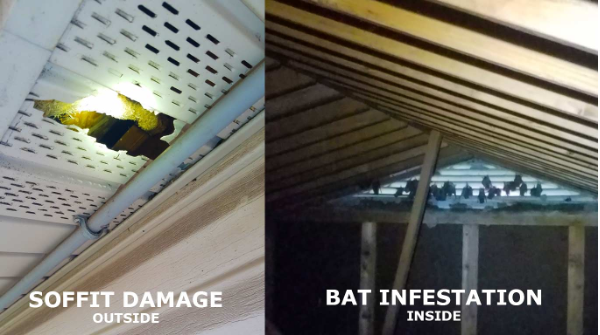
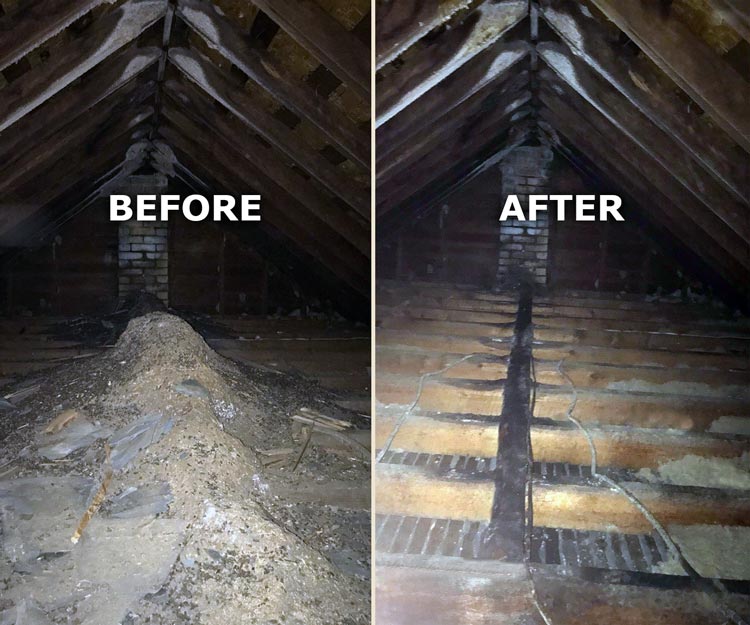
Varment Guard’s Attic Clean Out and Restoration Process:
-
Attic restoration starts with removal of all bat guano (bat droppings) and damaged insulation
-
We then disinfect a deodorize to kill bacteria, fungus, parasites, and odor left behind from bat colonies
-
We finish by installing new cellulose insulation to meet or exceed state-required insulation values
In some situations, complete insulation removal may not be needed and in those cases we can provide partial clean-out along with disinfecting, deodorizing, and fresh cap of the new cellulose insulation.
Varment Guard: The Experts at Removing Bats Humanely
Intentionally harming bats is illegal, but removal from your attic is not. For your safety and the bat’s safety, bats should only be handled by a wildlife professional.
During the birthing season, bats cannot be excluded from a structure as the flightless young would not survive without parental care. Some states (like Ohio, for example) allow exclusion with a state-issued permit, but other states do not allow removal during the birthing season at all.
How We Can Help During Bat's Birthing Season
Varment Guard’s bat specialists can still help during the birthing season. We can inspect the structure and develop the eviction plan. We can also start by doing some of the exclusion work, as long as it will not prevent the bats from exiting or returning.
Once bat breeding season is over, we can quickly exclude the last areas and hang the one-way door. One-way doors typically hang for 7-10 days to allow plenty of time for all the bats to exit.

Let Us Solve Your Bat Problem
Whether you’ve got bats in your walls, attic, chimney, or basement, we can provide you with humane bat removal services. Varment Guard’s bat experts have been removing bats from houses and businesses for decades. Additionally, all of Varment Guard’s bat exclusion comes with a 5-year warranty.
Remember, removing a bat (or a colony) is not a DIY project. We are licensed and state certified professional bat removal specialists. Contact Varment Guard today so we can start bat-proofing your home, removing existing bats, and repairing bat-related damage.
Frequently Asked Questions
Does One Bat in the House Mean More Are Inside?
No, not always. But there’s always a chance there may be more living in your attic. If you see multiple bats in your house, then that’s a sign of an infestation. To get peace of mind and make sure your space is bat-free, call Varment Guard. One of our expert technicians will come to your home and inspect your space!
How Do I Prevent Bats From Entering My Attic?
Here’s how to keep bats from entering your space:
- Find and repair gaps. Bats can squeeze through a space as small as a dime, so no gap, crack, or opening should be overlooked. Caulk any spaces where a bat could fit through.
- Use chimney covers. Chimney covers are bat-proof screens that fit over the top of a chimney and keep animals out without restricting air flow.
- Hire a professional wildlife team. We can provide prevention services or remove an existing bat infestation. It is crucial that bats remain unharmed. The best way to do this is to hire professional bat experts who can get and keep the animals out without hurting them.
How Small of a Space Can a Bat Fit Through?
Bats can squeeze through holes as small as a dime (⅜ in by ⅞ in).
How Do Bats Get in My House?
Bats enter homes through damaged roofs and siding, vents, chimneys, open windows, and any gaps in the framing. It is crucial to keep up with household maintenance and patch any areas where bats could enter. Learn more about how bats can find their way into your home.

